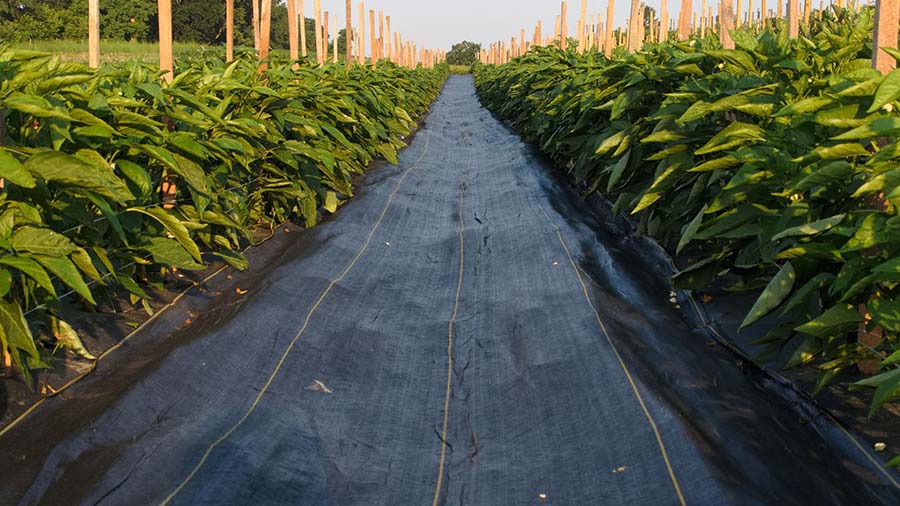Happy Plants in Raised Beds: Using Geotextiles as Permeable Liners
If you’re a fan of raised garden beds, you’ll appreciate another clever use for woven landscape fabric: as a permeable liner. While the wooden or metal sides of a raised bed provide structure and define your growing space, lining the inside with woven geotextile can offer several benefits for your plants’ health.
First, a liner prevents soil from directly contacting and potentially degrading the bed’s structural material, especially wood, over years of use. This protection can keep your raised beds in good shape for many years. More importantly, a permeable geotextile allows your beds to drain without carrying the soil with it. Adequate drainage prevents waterlogging and root rot, a common issue in raised beds. At the same time, the fabric’s weave keeps the soil contained so it doesn’t wash out during heavy rains.
For raised beds set directly on the ground, a permeable woven liner creates a durable barrier between the ordinary soil below and the nutrient-rich soil in your raised bed. It encourages drainage but prevents weeds from creeping up into your planting area from the ground beneath.
Temperature Control for Happy Roots: How Geotextiles Can Influence Soil Temperature
Many gardeners have discovered that woven landscape fabric can also indirectly influence soil temperature, which can be a bonus for certain plants and in specific climates. As we briefly touched on in Chapter 4, the fabric’s color plays a role here. Black woven fabric absorbs solar radiation and can slightly warm the soil underneath. This can be advantageous in cooler spring months, where fast germination and growth are the goal, or for heat-loving crops like tomatoes and peppers.
Conversely, lighter-colored or white woven fabrics reflect sunlight, which may help keep the soil cooler during hot summers. This can benefit plants that prefer cooler root temperatures, such as lettuce and spinach, and can also help reduce water evaporation from the soil surface in intense heat. The effect is subtle but can be valuable in managing your garden’s microclimate.
Try This: Comparing Soil Temperatures Under Black Fabric
To observe the soil-warming effect of black woven landscape fabric, try this: On a sunny day, choose two identical, small garden beds or sections of bare soil. Cover one entirely with black woven landscape fabric and secure the edges. Leave the other uncovered. After a few hours in direct sunlight, use a soil thermometer to measure the temperature of the soil a few inches below the surface in both the covered and uncovered areas. You may notice a slightly higher temperature in the soil beneath the black fabric.
Large-Scale Solutions: Agricultural Weed Mats and Ground Cover
Of course, the principles that make woven landscape fabric effective in home gardens also apply to larger-scale agricultural and commercial landscaping. In these settings, high-quality, durable woven geotextiles are often used as weed mats and ground covers over large areas. They provide long-lasting weed suppression, reduce the need for herbicides, and can even help with moisture retention when coupled with drip irrigation systems. While the scale differs, the core benefits of durability, permeability, and effective weed control remain the same.
Creative Uses: Under Decking and Walkway Blocks
Think beyond the traditional garden bed! Woven landscape fabric can also be employed creatively around your property.
Under Wooden Decking
Laying woven landscape fabric beneath a wooden deck before construction or even retroactively can significantly reduce the weeds that pop up through gaps between deck boards or creep out past the edges. This eliminates awkward weeding chores and the need for harsh chemicals to treat hard-to-reach areas. Even better, water can still pass through to the soil, so you’re not suddenly faced with new drainage problems.
Separator Under Walkway Blocks or Bricks
When installing a walkway or patio with individual blocks or bricks, placing a layer of woven landscape fabric over the prepared sub-base helps keep the blocks from settling unevenly into the soil and inhibits weeds from emerging in the joints.
Taming Overly Generous Drainage: Keeping Soil Where it Belongs in Containers
Many container gardeners are familiar with the frustration of pots and planters equipped with huge drainage holes. While intended to offer good drainage, these pots and planters end up losing potting mix with each watering, especially for light mixes. This depletes soil over time and can create a messy situation. Unfortunately, adding clay shards or rocks to the container’s base slows the loss.
By lining the bottom of your containers with a small piece of woven landscape fabric before adding your potting mix, you have a simple yet effective solution. The fabric’s weave acts like a sieve or colander, keeping the soil particles contained while excess water is free to drain.
Try This: Preventing Soil Loss in a Container
The next time you’re planting or repotting in a container with substantial drainage holes, cut a piece of woven landscape fabric slightly larger than the bottom of the pot. Place it inside the pot so that it’s covering the drainage holes. You can even extend it up the sides a little. Then, add your potting mix and plant as usual. Water the container thoroughly and observe the water draining out. You’ll see significantly less soil washing out compared to planting directly in the pot without the liner.
Looking Ahead
From keeping weeds at bay in your garden beds to enhancing the performance of your containers, you’ve seen several ways to use woven landscape fabric outside your garden. In the next chapter, we’ll explore essential maintenance practices and share a few pro tips to keep your woven landscape fabric delivering its benefits season after season.




